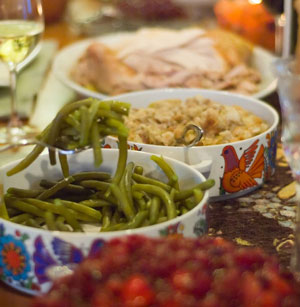 Thanksgiving is a great meal. Friends and family come together to give thanks and celebrate the harvest season–
Thanksgiving is a great meal. Friends and family come together to give thanks and celebrate the harvest season–
…and to overeat.
All of us know the feeling of eating too much, too heavy, too rich. When we should be enjoying our time with loved ones, we are uncomfortable. We exasperate our health conditions and catch a cold. We put on weight and feel lethargic.
I’m not going to tell you to make dramatic changes to your Thanksgiving meal. Usually that doesn’t work—and besides, it’s no fun.
Instead I suggest you just make small choices. Pick one food instead of the other. Make little positive choices and they’ll add up to a healthier, more enjoyable meal.
The Best and Worst Thanksgiving Foods
Before we begin, let’s set some ground rules.
Obviously, everyone uses different recipes and buys different products. Nutritional value of Thanksgiving foods can vary widely. And everyone has different health concerns—from watching calories, to cutting cholesterol to boosting their immune system.
The “Best and Worst Thanksgiving Foods” list is intended as a general guideline. Consider the overall nutritional value of each food—calories, fats, nutrients and additives. Which food moves you closest to your health goals?
Dark Meat vs. White Meat
This is the classic Thanksgiving debate. But for health, white meat has the advantage. For each 3oz serving, white meat has 50 fewer calories and 4g less fat than dark. And at Thanksgiving, you’re bound to eat more than 3oz.
The best: White meat. Enjoy your turkey but pass on the dark meat.
Sweet Potatoes vs. Mashed Potatoes
Generally potatoes are a healthy food. I especially recommend sweet potatoes for fall and winter diets. But when you add Thanksgiving condiments to potatoes, they lose their nutritional standing. Gravy or butter makes mashed potatoes full of fat. And adding sugar or marshmallows to sweet potatoes makes them closer to dessert than a vegetable.
The best: Savory sweet potatoes. Bake diced sweet potatoes with a tiny bit of olive oil, garlic and rosemary for a delicious and nutritious side dish.
Clearly the worst: Mashed potatoes swimming in butter or gravy.
Homemade Gravy vs. Canned Gravy
Gravy is delicious—but bad for your health. Basically, gravy is fat.
One quarter cup of homemade gravy has 18g fat, most of which is saturated, and contains virtually no nutrients. On the other hand, canned gravy has less fat but it’s high in salts, sugar and preservatives.
The best: Both are equally bad. The best choice is to eat very small amounts (or none).
Brussel Sprouts vs. Collard Greens
This one is a trick question—they are both good. Skip the recipes with bacon fat; steam these up and fill your plate. They are good for you and they fill you up so you don’t overeat other foods.
The best: Tie for first place.
Homemade Cranberry Sauce vs. Canned Cranberry Sauce
Cranberries are healthy and full of phytochemicals, which help protect against urinary tract infections, inflammation and cancer. Unfortunately, cranberry sauce is a different matter. Canned cranberry sauce can have high fructose corn syrup. You can leave the corn syrup out of homemade sauce, but many recipes call for lots of sugar.
The best: Homemade cranberry sauce.
Bonus choices: Reduce the sugar in the recipe or skip the cranberry sauce altogether and save your sugar for dessert.
Beer vs. Wine
The beer vs. wine debate is hotly contested, with each side claiming victory. Generally a serving of wine has fewer calories than beer and in some studies it is linked to cardiovascular health and lower cholesterol. On the other hand, a serving of beer generally has more nutrients and less alcohol than wine.
The best: You pick based on your health concerns. Are you watching calories or alcohol intake? In both cases, moderation is best.
Apple Pie vs. Pumpkin Pie
Both apples and pumpkins are a healthy start, but they take a turn when they become pie. Pies have a lot of fat in the crust and sugar in the filling.
Which is healthier? Pumpkin pie weighs in with 95 fewer calories and 5g less fat than apple pie, mainly because it has only one crust and is topped with a small dollop of whipped cream instead of a large scoop of ice cream.
The best: Pumpkin pie. Bonus if you pass on the whipped cream.
Whipped Cream vs. Ice Cream
This is a tough comparison because there is a wide range of products in each category. From Cool Whip to homemade whipped cream, from “frozen dairy dessert” (read the label of cheap ice creams and you’ll see this description) to real ice cream—there is a wide range of ingredients.
Obviously, both have fats and sugars. But one big difference between the two is how they are served. Generally a scoop of ice cream on a piece of pie can be at least half a cup, while a dollop of whipped cream is closer to two tablespoons. A serving of whipped cream is simply smaller than a serving of ice cream.
In both cases, check the ingredient labels for pure natural ingredients. Homemade gives you more control of the ingredients but choose your recipes wisely. Whipping cream has less fat than heavy cream, but it’s the high fat content in the recipes that make it “good.”
The best: Whipping cream. Bonus if you stick to two tablespoons.
Happy Thanksgiving
Best wishes for a fun Thanksgiving feast. May you and your loved ones have safe travels and good times.


